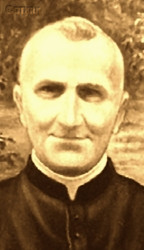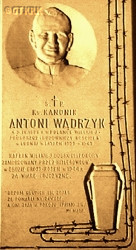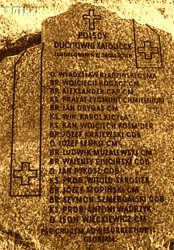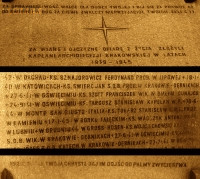Roman Catholic
St Sigismund parish
05-507 Słomczyn
85 Wiślana Str.
Konstancin deanery
Warsaw archdiocese, Poland
full list:
displayClick to display full list

searchClick to search full list by categories
wyświetlKliknij by wyświetlić pełną listę po polsku

szukajKliknij by przeszukać listę wg kategorii po polsku

Martyrology of the clergy — Poland
XX century (1914 – 1989)
personal data
surname
WĄDRZYK
forename(s)
Anthony (pl. Antoni)
function
diocesan priest
creed
Latin (Roman Catholic) Church RCmore on
en.wikipedia.org
[access: 2014.09.21]
diocese / province
Cracow archdiocesemore on
en.wikipedia.org
[access: 2013.05.19]
RC Military Ordinariate of Polandmore on
en.wikipedia.org
[access: 2014.12.20]
honorary titles
Expositorii Canonicalis canonmore on
en.wikipedia.org
[access: 2014.11.14]
(c. 1933)
date and place
of death
10.02.1945

KL Mauthausenconcentration camp
today: Mauthausen, Perg dist., Salzburg state, Austria
more on
en.wikipedia.org
[access: 2022.01.09]
alt. dates and places
of death
12.1944
KL Groß‐Rosenconcentration camp
today: Rogoźnica, Strzegom gm., Świdnica pov., Lower Silesia voiv., Poland
more on
en.wikipedia.org
[access: 2019.02.02]
details of death
In 1927 and 1929 appointed reserve chaplain of the Polish Army (first time by order of the President of the Republic of Poland of 01.09.1927, with seniority from 01.01.1927 and 102nd place among the Roman Catholic military clergy; each time for a statutory 2‐year period).
After German and Russian invasion of Poland in 09.1939 and start of the World War II, after start of German occupation, arrested by the Germans — agents of SiPo und SD security services — on 20.06.1943 during pacification of Krzeczów village (organized by the Germans under the code name «Grossaktion Dora») — suspected of collaboration with Polish resistance (part of Polish Clandestine State).
During pacification Germans murdered c. 22 parishioners.
Tortured and next transported to the Germ. Geheime Staatspolizei (Eng. Secret State Police), i.e. Gestapo, headquarters at Pomorska Str. and Montelupich Str. prison in Kraków.
On 01.10.1943 transported to KL Auschwitz concentration camp.
From there on 08.11.1943 moved to KL Mauthausen concentration camp.
Perished during camp evacuation, from exhaustion in a quarry.
Or, alternatively, „trampled with boots into the mud” by camp's kapo.
alt. details of death
According to some sources moved to KL Groß‐Rosen concentration camp where perished during the days prior to evacuation of the camp to the west.
prisoner camp's numbers
3999Click to display source page (KL MauthausenClick to display the description)
cause of death
murder
perpetrators
Germans
sites and events
KL MauthausenClick to display the description, KL Mauthausen‐GusenClick to display the description, KL Groß‐RosenClick to display the description, KL AuschwitzClick to display the description, Regierungsbezirk KattowitzClick to display the description, Cracow (Montelupich)Click to display the description, «Grossaktion Dora» in KrzeczówClick to display the description, GeneralgouvernementClick to display the description, Ribbentrop‐MolotovClick to display the description, Pius XI's encyclicalsClick to display the description
date and place
of birth
05.04.1888

Polanka Wielkatoday: Polanka Wielka gm., Oświęcim pov., Lesser Poland voiv., Poland
more on
en.wikipedia.org
[access: 2021.12.18]
alt. dates and places
of birth
03.04.1888
parents
WĄDRZYK Adalbert
🞲 ?, ? — 🕆 ?, ?

WALICKA Louise
🞲 ?, ? — 🕆 ?, ?
presbyter (holy orders)
ordination
29.06.1914

positions held
1932 – 1943
parish priest — Lubieńtoday: Lubień gm., Myślenice pov., Lesser Poland voiv., Poland
more on
en.wikipedia.org
[access: 2021.12.18]
en.wikipedia.org
[access: 2020.07.31] ⋄ St John the Baptist RC parish ⋄ Mszana Dolnatoday: Mszana Dolna gm., Limanowa pov., Lesser Poland voiv., Poland
more on
en.wikipedia.org
[access: 2020.07.31] RC deanery
1927 – 1932
curatus/rector/expositus — Mikuszowicetoday: district of Bielsko‐Biała, Bielsko‐Biała city pov., Silesia voiv., Poland
more on
en.wikipedia.org
[access: 2021.12.18] ⋄ St Barbara the Virgin and Martyr RC church ⋄ Biała Krakowskatoday: district of Bielsko‐Biała, Bielsko‐Biała city pov., Silesia voiv., Poland
more on
en.wikipedia.org
[access: 2021.12.18], Divine Providence RC parish ⋄ Biała Krakowskatoday: district of Bielsko‐Biała, Bielsko‐Biała city pov., Silesia voiv., Poland
more on
en.wikipedia.org
[access: 2021.12.18] RC deanery
1921 – c. 1926
prefect — Biała Krakowskatoday: district of Bielsko‐Biała, Bielsko‐Biała city pov., Silesia voiv., Poland
more on
en.wikipedia.org
[access: 2021.12.18] ⋄ primary schools ⋄ Divine Providence RC parish ⋄ Biała Krakowskatoday: district of Bielsko‐Biała, Bielsko‐Biała city pov., Silesia voiv., Poland
more on
en.wikipedia.org
[access: 2021.12.18] RC deanery — e.g. in Leszczyny
1920 – 1921
vicar — Krzeszówtoday: Stryszawa gm., Sucha Beskidzka pov., Lesser Poland voiv., Poland
more on
en.wikipedia.org
[access: 2021.12.18] ⋄ Blessed Virgin Mary of Perpetual Help RC parish ⋄ Sucha Beskidzkatoday: Sucha Beskidzka urban gm., Sucha Beskidzka pov., Lesser Poland voiv., Poland
more on
en.wikipedia.org
[access: 2021.12.18] RC deanery
1917 – 1920
vicar — Rychwałdtoday: Gilowice gm., Żywiec pov., Silesia voiv., Poland
more on
en.wikipedia.org
[access: 2010.08.11] ⋄ St Nicholas the Bishop and Confessor RC parish ⋄ Żywiectoday: Żywiec urban gm., Żywiec pov., Silesia voiv., Poland
more on
en.wikipedia.org
[access: 2021.06.07] RC deanery
1916 – 1917
vicar — Krzeszówtoday: Stryszawa gm., Sucha Beskidzka pov., Lesser Poland voiv., Poland
more on
en.wikipedia.org
[access: 2021.12.18] ⋄ Blessed Virgin Mary of Perpetual Help RC parish ⋄ Sucha Beskidzkatoday: Sucha Beskidzka urban gm., Sucha Beskidzka pov., Lesser Poland voiv., Poland
more on
en.wikipedia.org
[access: 2021.12.18] RC deanery
c. 1916
vicar — Zebrzydowicetoday: Kalwaria Zebrzydowska gm., Wadowice pov., Lesser Poland voiv., Poland
more on
en.wikipedia.org
[access: 2021.12.18] ⋄ St Michael the Archangel RC parish ⋄ Skawinatoday: Skawina gm., Kraków pov., Lesser Poland voiv., Poland
more on
en.wikipedia.org
[access: 2021.12.18] RC deanery
till 1914
student — Krakówtoday: Kraków city pov., Lesser Poland voiv., Poland
more on
en.wikipedia.org
[access: 2021.06.07] ⋄ philosophy and theology, Theological Seminary ⋄ Kraków RC archdiocese
others related
in death
BŁĄDZIŃSKIClick to display biography Vladislav, BOGACZClick to display biography Adalbert, CAGClick to display biography Joseph, CAPClick to display biography Alexander, CHMIELNICKIClick to display biography Sigismund, DRYGASClick to display biography Francis, DRYGASClick to display biography John, GRYŹLAKClick to display biography Anthony, JĘDRAClick to display biography Martin, KOŚMIDERClick to display biography Adalbert, KRAJEWSKIClick to display biography Joseph, LEŃKOClick to display biography Joseph, ŁUKOWIAKClick to display biography Anthony, PLUCIŃSKIClick to display biography Valentine, PYKOSZClick to display biography John, SAROSIEKClick to display biography Witold, STOPIŃSKIClick to display biography Joseph, SZMERGALSKIClick to display biography Simon, WIĘCKIEWICZClick to display biography Leo, ŻUREKClick to display biography Anthony, BUKOWSKIClick to display biography Leopold, CZUBINClick to display biography Francis
sites and events
descriptions
KL Mauthausen: German Germ. Konzentrationslager (Eng. concentration camp) KL, „Grade III” (Germ. „Stufe III”), part of KL Mauthausen‐Gusen complex, intended for the „Incorrigible political enemies of the Reich”. The prisoners slaved at a nearby granite quarry, but also in local private companies. Set up in 08.1938 initially served as a prison camp for common criminals, prostitutes and other categories of „Incorrigible Law Offenders”, but on 08.05.1939 was converted into a labour camp for political prisoners. (more on: en.wikipedia.orgClick to attempt to display webpage
[access: 2014.03.10])
KL Mauthausen‐Gusen: A large group of German Germ. Konzentrationslager (Eng. concentration camp) KL camps set up around the villages of Mauthausen and Gusen in Upper Austria, c. 30 km east of Linz, operational from 1938 till 05.1945. Over time it became of the largest labour camp complexes in the German‐controlled part of Europe encompassing four major camps concentration camps (KL Mauthausen, KL Gusen I, KL Gusen II and KL Gusen III) and more than 50 sub‐camps where inmates slaved in quarries — the granite extracted, previously used to pave the streets of Vienna, was intended for a complete reconstruction of major German towns according to the plans of the chief architect of National Socialist Germany, the Germ. Generalbauinspektor für die Reichshauptstadt (Eng. General Building Inspector for the Reich Capital) and from 1942 also, i.a. the Germ. Reichsminister für Bewaffnung und Munition (Eng. Reich Minister for Armaments and Ammunition), Albert Speer — munitions factories, mines, arms factories and Me 262 fighter‐plane assembly plants. The complex served the needs of the German war machine and also carried out extermination through labour. Initially did not have a its own gas chamber and the intended victims were mostly moved to the infamous euthanasia center in the Schloss Hartheim castle w Alkoven, 40.7 km east, or killed by lethal injection and cremated in the local crematorium. Later a van with the exhaust pipe connected to the inside shuttled between KL Mauthausen and KL Gusen. In 12.1941 a permanent gas chamber was built. C. 122,000‐360,000 of prisoners perished. Many Polish priests were held, including those captured during the program of extermination of Polish intelligentsia («Intelligenzaktion»). The camp complex was founded and run as a source for cheap labour for private enterprise. (more on: en.wikipedia.orgClick to attempt to display webpage
[access: 2014.03.10])
KL Groß‐Rosen: Groß‐Rosen (today: Rogoźnica) was a German Germ. Konzentrationslager (Eng. concentration camp) KL, founded in the summer of 1940 (first transport of prisoners arrived on 02.08.1940). Initially a branch of KL Sachsenhausen concentration camp. In 1944 became a centre of a network of more than 100 camps. Prisoners were forced to slave at nearby granite quarries, on starvation rations. More than 125,000 prisoners were enslaved — 40,000 victims perished. In 1945 — in „death marches” — Germans dragged through the camp thousands of prisoners from the camp’s in east being one by one overrun by the Russians. The camp itself was captured by the Russians on 14.02.1945. (more on: www.gross-rosen.euClick to attempt to display webpage
[access: 2021.07.18], en.wikipedia.orgClick to attempt to display webpage
[access: 2019.02.02])
KL Auschwitz: German Germ. Konzentrationslager (Eng. concentration camp) KL and Germ. Vernichtungslager (Eng. extermination camp) VL Auschwitz was set up by Germans around 27.01.1940 n. Oświęcim, on the German territory (initially in Germ. Provinz Schlesien — Silesia Province; and from 1941 Germ. Provinz Oberschlesien — Upper Silesia Province). Initially mainly Poles were interned. From 1942 it became the centre for holocaust of European Jews. Part of the KL Auschwitz concentration camps’ complex was Germ. Vernichtungslager (Eng. extermination camp) VL Auschwitz II Birkenau, located not far away from the main camp. There Germans murdered likely in excess of million people, mainly Jews, in gas chambers. In KL Auschwitz alone, the Germans murdered c. 30,000 prisoners by lethal injection. Until 1941, people were killed by intravenous injections of concentrated hydrogen peroxide, ether, hydrogen peroxide, or gasoline. Later, an intracardiac injection was used — with a needle about 10 cm long — of 10‐15 ml of a 30% solution of phenol C6H5OH (acquired from the German concern IG Farben, or more precisely from its subsidiary Bayer, and still used by Bayer AG, among others, for the production of aspirin), which killed within 15 seconds. Altogether In excess of 400 priests and religious went through the KL Auschwitz, c. 40% of which were murdered (mainly Poles). (more on: en.auschwitz.org.plClick to attempt to display webpage
[access: 2012.11.23], www.meczennicy.pelplin.plClick to attempt to display webpage
[access: 2013.07.06])
Regierungsbezirk Kattowitz: After the Polish defeat in the 09.1939 campaign, which was the result of the Ribbentrop‐Molotov Pact and constituted the first stage of World War II, and the beginning of German occupation in part of Poland (in the other, eastern part of Poland, the Russian occupation began), the Germans divided the occupied Polish territory into five main regions (and a few smaller). The largest one was transformed into Germ. Generalgouvernement (Eng. General Governorate), intended exclusively for Poles and Jews and constituting part of the so‐called Germ. Großdeutschland (Eng. Greater Germany). From two separate new provinces were created. The two remaining were incorporated into existing German provinces. One of those was Polish Upper Silesia, which on 08.09.1939, by decree of the German leader Adolf Hitler (formally came into force on 26.10.1939), was incorporated into Germany as the Germ. Regierungsbezirk Kattowitz (Eng. Katowice Regency) and became part of the Germ. Provinz Schlesien (Eng. Province of Silesia) based in Wrocław. On 01.04.1940, the Germ. Regierungsbezirk Kattowitz was enlarged by several pre‐war German counties, and on 18.01.1941, a new German province was created, the Germ. Provinz Oberschlesien (Eng. Province of Upper Silesia), which, apart from the Germ. Regierungsbezirk Kattowitz, also included the Opole region. From 26.10.1939, when the regency was established, the law of the German state was in force there, the same as in Berlin. The main axis of the policy of the new regency, the territory of which the Germans recognized as the Germ. „Ursprünglich Deutsche” (Eng. „natively German”), despite the fact only 6% of its pre–war Polish part were Germans, was Germ. „Entpolonisierung” (Eng. „Depolonisation”), i.e. forced Germanization. The main mechanism was the introduction of the Germ. Deutsche Volksliste DVL, a German nationality list that was supposed to specify the national affiliation of the inhabitants of the region. The largest group marked in the compulsory registrations was Group 3, people who identified themselves as „Silesians” (in 1943 about 41%), and people remaining outside the DVL (about 36%). The latter group was intended to be deported to the Germ. Generalgouvernement (which did not happen en masse because German industry needed slave labor). Group 3, considered by the Germans as capable of Germanization, was subject to certain legal restrictions, and was subject to, among others, to conscription into the German Wehrmacht army. Children could only learn in German. A policy of terror was pursued against the Polish population. There was a special police court, controlled by the Germ. Geheime Staatspolizei (Eng. Secret State Police), i.e. the Gestapo, before which c. 4,000‐5,000 people were detained. For the years 1942‐1945 over 2,000 of them were verified, of which 1,890 were sentenced to death, including 286 in public executions. Thousands of people were murdered during the so‐called «Intelligenzaktion Schlesien», including 300‐650 Polish teachers and c. 61 Polish Catholic priests. The regency hosted a German concentration and extermination camp KL Auschwitz, where the Germans imprisoned c. 1,100,000 Jews (murdering c.1,000,000, i.e. c. 90% of them) and c. 140,000 Poles (murdering c. 70,000, i.e. c. 50% of them). After the end of hostilities of World War II, the overseer of this province, the Germ. Reichsstatthalter (Eng. Reich Governor) and the Germ. Gauleiter (Eng. district head) of the German National Socialist Party, Fritz Brecht, committed suicide. (more on: en.wikipedia.orgClick to attempt to display webpage
[access: 2024.06.24])
Cracow (Montelupich): Cracow penal prison, during occupation run by the Germans — from 28.02.1941 by Germ. Geheime Staatspolizei (Eng. Secret State Police, known as Gestapo. In 1940‐1944 Germans jailed there approx. 50,000 prisoners, mainly Poles and Jews. Some of them were transported to KL Auschwitz concentration camp, some were executed. After cease in war effort the prison was used by UB — a Polish unit of Russian NKVD — as a prison for Polish independence resistance fighters, some of which were subsequently sent to prisons and slave labour camps in Russia. (more on: en.wikipedia.orgClick to attempt to display webpage
[access: 2014.10.31])
«Grossaktion Dora» in Krzeczów: 20.06.1943 the Germans — led by Germ. Inspektor Sicherheitspolizei und SD (Eng. head of the security service) from Zakopane, de facto head of the border police station and Germ. Geheime Staatspolizei (Eng. Secret Political Police), i.e. Gestapo, in Zakopane — carried out, under the codename «Grossaktion Dora», the pacification of the village of Krzeczów. The Polish resistance of the Union of Armed Struggle ZWZ, transformed in 1942 into the Home Army AK, together with partisan units (part of the Polish Underground State), part of the Kraków ZWZ‐AK Inspectorate structures, operated in the village. Initially, mainly information activities, distribution of underground press, were carried being out, but over time military training was implemented. Weapons were secured for the needs of the planned uprising. In 1942, the ZWZ‐AK had 9 sworn men, with 8 rifles and several hundred rounds of ammunition. In 1943, the Germans found out about the group — mainly due to the conspirators' carelessness. On the night of 19—20.06.1943 surrounded the village. During the pacification Germans murdered 10 people in clashes, 9 (including one Catholic priest) were executed in the local cemetery after interrogation and bloody torture. 3 were murdered in the nearby village of Tenczyn. Several people, including two priests and one nun, were taken to concentration camps. Several residential buildings were burned down. (more on: krakow.ipn.gov.plClick to attempt to display webpage
[access: 2024.09.11])
Generalgouvernement: After the Polish defeat in the 09.1939 campaign, which was the result of the Ribbentrop‐Molotov Pact and constituted the first stage of World War II, and the beginning of German occupation in part of Poland (in the other, eastern part of Poland, the Russian occupation began), the Germans divided the occupied Polish territory into five main regions. In two of them new German provinces were created, two other were incorporated into other provinces. However, the fifth part was treated separately, and in a political sense it was supposed to recreate the German idea from 1915 (during World War I, after the defeat of the Russians in the Battle of Gorlice in 05.1915) of creating a Polish enclave within Germany. Illegal in the sense of international law, i.e. Hague Convention, and public law, managed by the Germans according to separate laws — especially established for the Polish Germ. Untermenschen (Eng. subhumans) — till the Russian offensive in 1945 it constituted part of the Germ. Großdeutschland (Eng. Greater Germany). Till 31.07.1940 formally called Germ. Generalgouvernement für die besetzten polnischen Gebiete (Eng. General Government for the occupied Polish lands) — later simply Germ. Generalgouvernement (Eng. General Governorate), as in the years 1915‐1918. From 07.1941, i.e. after the German attack on 22.06.1941 against the erstwhile ally, the Russians, it also included the Galicia district, i.e. the Polish pre‐war south‐eastern voivodeships. A special criminal law was enacted and applied to Poles and Jews, allowing for the arbitrary administration of the death penalty regardless of the age of the „perpetrator”, and sanctioning the use of collective responsibility. After the end of the military conflict of the World War UU, the government of the Germ. Generalgouvernement was recognized as a criminal organization, and its leader, governor Hans Frank, guilty of war crimes and crimes against humanity and executed. (more on: en.wikipedia.orgClick to attempt to display webpage
[access: 2024.12.13])
Ribbentrop‐Molotov: Genocidal Russian‐German alliance pact between Russian leader Joseph Stalin and German leader Adolf Hitler signed on 23.08.1939 in Moscow by respective foreign ministers, Mr. Vyacheslav Molotov for Russia and Joachim von Ribbentrop for Germany. The pact sanctioned and was the direct cause of joint Russian and German invasion of Poland and the outbreak of the World War II in 09.1939. In a political sense, the pact was an attempt to restore the status quo ante before 1914, with one exception, namely the „commercial” exchange of the so‐called „Kingdom of Poland”, which in 1914 was part of the Russian Empire, fore Eastern Galicia (today's western Ukraine), in 1914 belonging to the Austro‐Hungarian Empire. Galicia, including Lviv, was to be taken over by the Russians, the „Kingdom of Poland” — under the name of the General Governorate — Germany. The resultant „war was one of the greatest calamities and dramas of humanity in history, for two atheistic and anti‐Christian ideologies — national and international socialism — rejected God and His fifth Decalogue commandment: Thou shall not kill!” (Abp Stanislav Gądecki, 01.09.2019). The decisions taken — backed up by the betrayal of the formal allies of Poland, France and Germany, which on 12.09.1939, at a joint conference in Abbeville, decided not to provide aid to attacked Poland and not to take military action against Germany (a clear breach of treaty obligations with Poland) — were on 28.09.1939 slightly altered and made more precise when a treaty on „German‐Russian boundaries and friendship” was agreed by the same murderous signatories. One of its findings was establishment of spheres of influence in Central and Eastern Europe and in consequence IV partition of Poland. In one of its secret annexes agreed, that: „the Signatories will not tolerate on its respective territories any Polish propaganda that affects the territory of the other Side. On their respective territories they will suppress all such propaganda and inform each other of the measures taken to accomplish it”. The agreements resulted in a series of meeting between two genocidal organization representing both sides — German Gestapo and Russian NKVD when coordination of efforts to exterminate Polish intelligentsia and Polish leading classes (in Germany called «Intelligenzaktion», in Russia took the form of Katyń massacres) where discussed. Resulted in deaths of hundreds of thousands of Polish intelligentsia, including thousands of priests presented here, and tens of millions of ordinary people,. The results of this Russian‐German pact lasted till 1989 and are still in evidence even today. (more on: en.wikipedia.orgClick to attempt to display webpage
[access: 2015.09.30])
Pius XI's encyclicals: Facing the creation of two totalitarian systems in Europe, which seemed to compete with each other, though there were more similarities than contradictions between them, Pope Pius XI issued in 03.1937 (within 5 days) two encyclicals. In the „Mit brennender Sorge” (Eng. „With Burning Concern”) published on 14.03.1938, condemned the national socialism prevailing in Germany. The Pope wrote: „Whoever, following the old Germanic‐pre‐Christian beliefs, puts various impersonal fate in the place of a personal God, denies the wisdom of God and Providence […], whoever exalts earthly values: race or nation, or state, or state system, representatives of state power or other fundamental values of human society, […] and makes them the highest standard of all values, including religious ones, and idolizes them, this one […] is far from true faith in God and from a worldview corresponding to such faith”. On 19.03.1937, published „Divini Redemptoris” (Eng. „Divine Redeemer”), in which criticized Russian communism, dialectical materialism and the class struggle theory. The Pope wrote: „Communism deprives man of freedom, and therefore the spiritual basis of all life norms. It deprives the human person of all his dignity and any moral support with which he could resist the onslaught of blind passions […] This is the new gospel that Bolshevik and godless communism preaches as a message of salvation and redemption of humanity”… Pius XI demanded that the established human law be subjected to the natural law of God , recommended the implementation of the ideal of a Christian state and society, and called on Catholics to resist. Two years later, National Socialist Germany and Communist Russia came together and started World War II. (more on: www.vatican.vaClick to attempt to display webpage
[access: 2023.05.28], www.vatican.vaClick to attempt to display webpage
[access: 2023.05.28])
sources
personal:
img.iap.plClick to attempt to display webpage
[access: 2021.12.19], krakow.ipn.gov.plClick to attempt to display webpage
[access: 2024.09.11]
bibliographical:
„International Tracing Service (ITS), Bad Arolsen, GermanyClick to display source page”, Arolsen Archives
original images:
img.iap.plClick to attempt to display webpage
[access: 2021.12.19], img.iap.plClick to attempt to display webpage
[access: 2021.12.19], img.iap.plClick to attempt to display webpage
[access: 2021.12.19], img.iap.plClick to attempt to display webpage
[access: 2021.12.19]
LETTER to CUSTODIAN/ADMINISTRATOR
If you have an Email client on your communicator/computer — such as Mozilla Thunderbird, Windows Mail or Microsoft Outlook, described at WikipediaPatrz:
en.wikipedia.org, among others — try the link below, please:
LETTER to CUSTODIAN/ADMINISTRATORClick and try to call your own Email client
If however you do not run such a client or the above link is not active please send an email to the Custodian/Administrator using your account — in your customary email/correspondence engine — at the following address:

giving the following as the subject:
MARTYROLOGY: WĄDRZYK Anthony
To return to the biography press below:
 Click to return to biography
Click to return to biography













